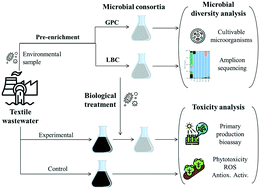Population dynamics of microbial native consortia efficient for textile wastewater degradation†
Abstract
Wastewater produced by textile industries is one of the most difficult effluents to treat due to its great volume, toxicity and variable composition. In this work, a comprehensive study on the degradation of pure textile effluent by two native bacterial consortia was conducted. The consortia were pre-enriched in Luria Bertani or glucose-potato media, termed as LBC and GPC, respectively. Consortia composition, structure and dynamics towards effluent biodegradation and toxicity analyses were conducted. Both bacterial communities degrade textile wastewater without pre-treatment and without the addition of nutritional sources, reducing TOC, COD and pH. One consortium was more efficient in achieving effluent decolorization and the reduction of COD, while the other showed better performance in reducing toxicity. Diversity analysis of both communities showed that there was no marked loss of diversity during degradation kinetics. The relative abundance of Gammaproteobacteria increased and within this group, Aeromonadal, Enterobacterial and Pseudomonadal were the main represented orders. The biodegradation ability of the isolated strains showed that none of them were able to degrade textile effluent independently. Toxicity assays showed the importance of carrying out these tests to appropriately select the final destination of the treated wastewater.



 Please wait while we load your content...
Please wait while we load your content...